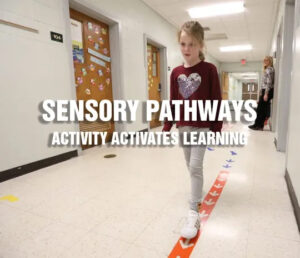
Kids in the Suffern Central school district may just be a hop, skip and jump away from doing better in class.
In the corridor leading to the kindergarten, first- and second-grade classrooms at Sloatsburg Elementary School, a colorful sequence of decals are affixed to the floor, creating a sensory pathway.
On a recent weekday morning, second-grader Sophia Rinaldi followed the path, leaping from one lily pad sticker to another and then onto a quick round of hop scotch. After that, the 7-year-old did some jumping jacks and wrapped up with a few wall push-ups.Sophia said she was having trouble sitting still at her seat that morning, so her teacher suggested she “go out into the hall.”
“I feel much better now. I’m more relaxed,” she said.
These days at Sloatsburg and Viola elementary schools, when students are fidgeting, unfocused or having trouble sitting still in class, teachers can send them out to a “sensory hallway” and through the path, which takes less than a minute. The idea is that youngsters will burn some energy and return ready to learn.
Ellen Stone, an occupational therapist at Viola who worked on the pathways, said that any type of movement can help kids settle down and refocus. “But this is about awareness of specific types of movement that impact the nervous system,” she said.
She said sensory exercises are particularly helpful for kids who have processing issues, stress, anxiety and ADHD.
“It’s designed in a way to hit different parts of the brain,” Stone said. “Students use their muscles and breathing and spatial awareness to get focused on the path. Afterward, they walk away reset and refreshed.”